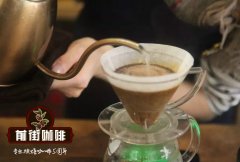How should Pacamara coffee beans be roasted? Why are the particles of Pacamara coffee so big?

Professional coffee knowledge exchange more coffee bean information please follow the coffee workshop (Wechat official account cafe_style)
The rare Nicaraguan Pacamara variety, with a special variety and limited production, is an improved variety of Maragogype and Pacamara, which is improved and produced in the natural environment of El Salvador. Soybeans are not necessarily of the best quality. Instead, the Nicaraguan Pacamara is a little smaller than Maragogype. The local price of the Pacamara variety is 3 times higher than that of ordinary beans. As precious as a pearl. Beans with very good balance! CITY is the best taste. Medium dry aroma: sweet fruit flavor; wet aroma: berry aroma, soft sour, slightly sweet taste.
The birth of Pacamara (Pacamara)
This legendary variety has a peculiar plant shape and raw bean shape, with huge leaves / tall trees / huge raw beans. Known as a variety of freaks in the country--
He was unknown and even made his debut in the 2003 / 04 COE competition because the judges thought the flavor was too strange to give high marks.
Until 2005, COE began to shine. In 2006, it directly arranged for the top four COE of SAP, and the Guatemala COE of 2008-10 was more by Pacamara of Injerto Manor, the direct champion for three years in a row!
Since then, it has established a leading position in the world of raw beans-unlike naturally evolved varieties such as geisha / bourbon / Tibica, Pacamara varieties are not naturally evolved or crossed naturally, but are bred by a group of excellent coffee breeders in El Salvador!
In 1958, more than half a century ago, the genetic breeding Department of the Salvadoran Coffee Research Center (ISIC) crossed for the first time a variety of bourbon-Pacas (Pacas) and a variety of Tibika-elephant bean / giant bean (Maragogype).
Since the crossing of two pure lines will produce F1 progenies with a large number of heteroconjugated gene pairs (in short, very impure lineages), the next step is to carry out multi-generation self-crossing before separating traits / purifying genes.
The self-pollination of each generation should start with artificial pollination and raise seedlings / colonize / grow into adults. This part will cost at least 3 Mel-4 years! At the same time, it is time-consuming and laborious to measure the individual performance of a large number of mutant offspring and select potential strains whose traits meet the requirements.
And then self-hand-in / nurture / selection. In this way, after five generations (F5), it has been 30 years, which almost consumes the life career of a young breeding expert before this variety can be bred!
But in fact, after only five generations of self-purification, the new variety still has a small number of heteroconjugated gene pairs, so some traits of Pacamara are still occasionally separated from Pacas or elephant bean / giant bean (Maragogype).
Qianjie Coffee suggests Pacamara Coffee Baking
Guatemala SHB coffee beans have high hardness. In order to fully stretch and develop the flavor, and to maintain the high-quality sour taste of Guatemalan coffee, we can take the operation of "pulling acid" when roasting-- increase the firepower at the turning yellow point, keep the temperature curve climbing steeply to achieve the purpose of increasing fire, promoting aroma and explosion, and the higher temperature rise also helps to remove some pepper flavor, while when it comes to an explosion and dense fire reduction, make a "sweetening" operation. To develop sweetness, turn off the heat and glide before adding beans to increase the taste and maturity. The smoky taste of Vivetna fruit will be more obvious in the deeper the baking degree, and the pepper flavor of Pacamara should use a lighter baking degree, so we designed the beans at about 13 degrees, and the coffee beans are at the end of the explosion, which belongs to shallow roasting.
END
Important Notice :
前街咖啡 FrontStreet Coffee has moved to new addredd:
FrontStreet Coffee Address: 315,Donghua East Road,GuangZhou
Tel:020 38364473
- Prev

El Salvador Santa Rosa Manor Coffee introduces what is the flavor of El Salvador coffee?
Professional coffee knowledge exchange more coffee bean information please follow the coffee workshop (Wechat official account cafe_style) A brief history of coffee in El Salvador: in the mid-19th century, El Salvador became independent from Nicaragua after the disintegration of the Union, and its cash crop was mainly locust blue, a crop used to make indigo dye until the mid-19th century, when chemical dyes were invented.
- Next

How to drink Puerto Rico Typica Iron pickup Coffee? Characteristics of Puerto Rico Yaoke Special Coffee
Exchange of professional coffee knowledge more coffee bean information Please follow Coffee Workshop (official Wechat account cafe_style) Coffee Workshop (official account Wechat) A very rare variety in Puerto Rico with limited production in only three export farms in the island countries, due to careful and time-consuming harvest (about 4 months during harvest), it is known as one of the most famous boutique coffee varieties in the world. There is a strong dry aroma
Related
- Detailed explanation of Jadeite planting Land in Panamanian Jadeite Manor introduction to the grading system of Jadeite competitive bidding, Red bid, Green bid and Rose Summer
- Story of Coffee planting in Brenka region of Costa Rica Stonehenge Manor anaerobic heavy honey treatment of flavor mouth
- What's on the barrel of Blue Mountain Coffee beans?
- Can American coffee also pull flowers? How to use hot American style to pull out a good-looking pattern?
- Can you make a cold extract with coffee beans? What is the right proportion for cold-extracted coffee formula?
- Indonesian PWN Gold Mandrine Coffee Origin Features Flavor How to Chong? Mandolin coffee is American.
- A brief introduction to the flavor characteristics of Brazilian yellow bourbon coffee beans
- What is the effect of different water quality on the flavor of cold-extracted coffee? What kind of water is best for brewing coffee?
- Why do you think of Rose Summer whenever you mention Panamanian coffee?
- Introduction to the characteristics of authentic blue mountain coffee bean producing areas? What is the CIB Coffee Authority in Jamaica?

